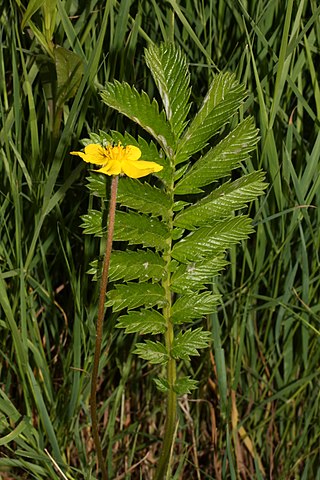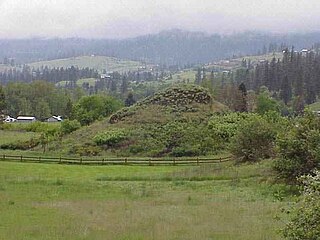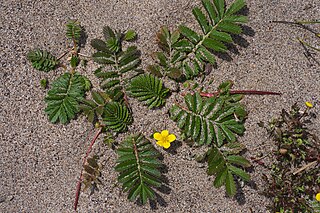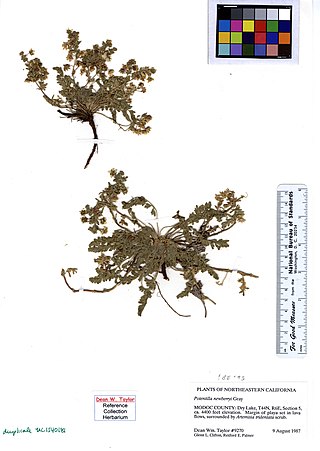
Potentilla is a genus containing over 500 species of annual, biennial and perennial herbaceous flowering plants in the rose family, Rosaceae.

Rubus spectabilis, the salmonberry, is a species of bramble in the rose family Rosaceae, native to the west coast of North America from west-central Alaska to California, inland as far as Idaho. Like many other species in the genus Rubus, the salmonberry plant bears edible fruit, typically yellow-orange or red in color, resembling raspberries in appearance.

Argentina anserina is a perennial flowering plant in the rose family, Rosaceae. It is known by the common names silverweed, common silverweed or silver cinquefoil. It is native throughout the temperate Northern Hemisphere, often on river shores and in grassy habitats such as meadows and road-sides. The plant was originally placed in the genus Potentilla by Carl Linnaeus in his Species plantarum, edition 1, (1753) but was reclassified into the resurrected genus Argentina by research conducted in the 1990s. The reclassification remains controversial and is not accepted by some authorities. It is a species aggregate which has frequently been divided into multiple species.

Camassia is a genus of plants in the asparagus family native to North America. Common names include camas, quamash, Indian hyacinth, camash, and wild hyacinth.

Indigenous peoples of the Northwest Plateau, also referred to by the phrase Indigenous peoples of the Plateau, and historically called the Plateau Indians are Indigenous peoples of the Interior of British Columbia, Canada, and the non-coastal regions of the Northwestern United States.

Argentina (silverweeds) is a genus of plants in the rose family (Rosaceae) which is accepted by some authors, as containing 64 species, but classified in Potentilla sect. Leptostylae by others.

Argentina egedei, known as Eged's silverweed, is a flowering perennial plant in the rose family, Rosaceae. It is a halophyte native to Arctic and cool temperate coasts of the Northern Hemisphere, most commonly growing in salt marshes. The southern limits of the range are California and Long Island, New York in North America, and the Baltic Sea and coastal eastern Siberia in Eurasia. It is also sometimes called "Pacific silverweed", though this usually refers to Argentina pacifica and in any case does not describe the range of Eged's Silverweed well.

Potentilla reptans, known as the creeping cinquefoil, European cinquefoil or creeping tormentil, is a flowering plant in the family Rosaceae.

Holodiscus discolor, commonly known as ocean spray or oceanspray, creambush, or ironwood, is a shrub of western North America.

Drymocallis arguta, commonly known as the tall cinquefoil, prairie cinquefoil, or sticky cinquefoil, is a perennial herbaceous plant native to North America. It was formerly included with the typical cinquefoils in the genus Potentilla.

The Indigenous peoples of the Pacific Northwest Coast are composed of many nations and tribal affiliations, each with distinctive cultural and political identities. They share certain beliefs, traditions and practices, such as the centrality of salmon as a resource and spiritual symbol, and many cultivation and subsistence practices. The term Northwest Coast or North West Coast is used in anthropology to refer to the groups of Indigenous people residing along the coast of what is now called British Columbia, Washington State, parts of Alaska, Oregon, and Northern California. The term Pacific Northwest is largely used in the American context.

Potentilla gracilis, known as slender cinquefoil or graceful cinquefoil, is a species of cinquefoil. It ranges from Alaska down the west coast of Canada and the United States, and Colorado.

Malus fusca, with the common names Oregon crabapple and Pacific crabapple, is a species of crabapple native to western North America.

Viburnum edule, the squashberry, mooseberry, moosomin, moosewood viburnum, pembina, pimina, highbush cranberry, or lowbush cranberry is a species of shrub native to Canada and the northern parts of the US. It stands roughly 2 m (6.5 ft) tall with many stems and smooth branches.

Potentilla diversifolia or Potentilla × diversifolia is a species of flowering plant in the Rose Family (Rosaceae) known by the common names varileaf cinquefoil, different-leaved cinquefoil, and mountain meadow cinquefoil.

Potentilla flabellifolia is a species of cinquefoil known by the common names high mountain cinquefoil, fanleaf cinquefoil and fan-foil.

Potentilla newberryi is a species of cinquefoil known by the common name Newberry's cinquefoil. It is native to the Pacific Northwest of the United States from Washington to the northeastern Modoc Plateau in California and Nevada.
















